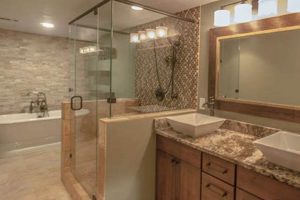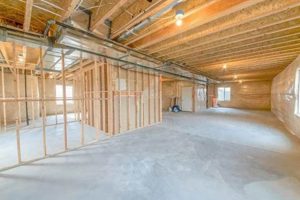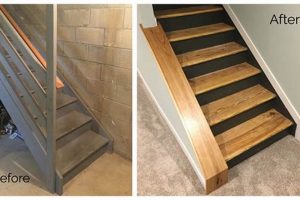The process of completing the construction of a staircase leading to a basement is a significant undertaking. This involves cladding the structural framework with aesthetically pleasing and durable materials to create a safe and functional access point. For example, unfinished stairs may consist of exposed framing lumber; finishing involves applying treads, risers, and stringers, often accompanied by a railing system.
Properly executed basement staircase completion enhances the overall property value, improves safety by eliminating hazards such as splinters and uneven surfaces, and increases the usability of the basement space. Historically, basement access was often utilitarian; modern finishing practices aim to integrate the staircase seamlessly into the home’s design aesthetic and improve the comfort and convenience of accessing the lower level.
The subsequent discussion will detail the essential steps involved in achieving a professionally finished basement staircase, including material selection, framing considerations, tread and riser installation, and railing implementation.
Essential Considerations for Basement Staircase Completion
The successful completion of a basement staircase requires careful planning and execution. The following tips provide guidance to ensure a safe, durable, and aesthetically pleasing result.
Tip 1: Accurate Measurement is Paramount: Prior to commencing any work, meticulously measure the existing stair framing. Inaccurate measurements can lead to material waste and structural instability. Double-check all dimensions to ensure proper fitment of treads and risers.
Tip 2: Prioritize Structural Integrity: Inspect the existing framing for any signs of weakness or damage. Reinforce any questionable areas before applying finishing materials. Securely fastening all components to the framing is crucial for long-term stability.
Tip 3: Select Durable Materials: Choose materials appropriate for a basement environment, which may be subject to moisture. Pressure-treated lumber for framing and moisture-resistant composite or solid wood options for treads and risers are advisable.
Tip 4: Implement Proper Fastening Techniques: Utilize construction adhesive in conjunction with screws or nails to secure treads and risers. This minimizes movement and reduces the likelihood of squeaking over time.
Tip 5: Ensure Consistent Tread Depth and Riser Height: Maintain uniform tread depth and riser height throughout the staircase. Variations can create tripping hazards and violate building codes. A stair gauge can assist in maintaining consistency.
Tip 6: Comply with Building Codes: Consult local building codes for specific requirements regarding staircase dimensions, handrail height and spacing, and headroom clearance. Adherence to these codes is essential for safety and legal compliance.
Tip 7: Focus on Proper Ventilation: Basements often have limited ventilation. Consider incorporating ventilation measures into the staircase design to reduce moisture buildup and prevent mold growth.
Effective execution of these tips will result in a professionally finished basement staircase that is both functional and visually appealing, adding value and safety to the home.
The concluding section will summarize the key aspects of the project, reinforcing the importance of careful planning and execution.
1. Accurate Measurements
Precise measurements are foundational to the successful completion of a basement staircase. Deviations from accurate dimensions compromise structural integrity, aesthetic harmony, and code compliance. Errors in measurement propagate throughout the project, leading to increased material waste, extended timelines, and potential safety hazards.
- Riser Height Uniformity
Inconsistent riser heights introduce tripping hazards. Accurate measurement ensures each riser maintains a uniform height, typically within a narrow tolerance specified by building codes. Variances as small as 3/8 inch can significantly increase the risk of falls. For instance, if the total staircase height is measured imprecisely, dividing that height into equal risers becomes problematic, resulting in non-compliant and dangerous steps.
- Tread Depth Consistency
Similar to riser height, consistent tread depth is essential for safe ambulation. Inaccurate measurements may result in treads that are too shallow to provide adequate foot support, particularly for individuals with limited mobility. Code regulations often specify a minimum tread depth. For example, a miscalculation during the initial framing can lead to insufficient space for the finished tread, requiring costly rework.
- Stringer Length and Angle
Stringers, the structural supports for the treads and risers, demand precise measurement and cutting. Incorrect stringer length affects the overall staircase rise and run, potentially leading to non-compliant and ergonomically unsound steps. An inaccurate angle can create an unstable staircase. Consider a scenario where the stringer angle is too steep; the resulting staircase might be difficult for elderly individuals to navigate.
- Handrail Placement and Height
Accurate measurements are vital for proper handrail installation. Handrails must be placed at a specific height and within a prescribed distance from the stair treads to provide adequate support and prevent falls. Code mandates often specify these dimensions. Failing to accurately measure the staircase’s dimensions can result in a handrail that is too high, too low, or inadequately positioned to provide effective assistance.
The preceding facets underscore the critical role of accurate measurements in the construction of a basement staircase. Neglecting this aspect introduces avoidable risks and expenses. The integration of precise measurements throughout the project is not merely a matter of convenience; it is fundamental to creating a safe, code-compliant, and aesthetically pleasing structure. Diligence in measurement is a direct investment in the project’s success and the long-term safety of its users.
2. Structural Integrity
Structural integrity forms the bedrock of any staircase, particularly in a basement setting where environmental factors can exacerbate structural weaknesses. The “how to finish stairs in basement” process fundamentally relies on a sound underlying framework; aesthetic enhancements become secondary if the core structure is compromised.
- Stringer Reinforcement and Attachment
Stringers are the primary load-bearing components of a staircase. Ensuring their robust construction and secure attachment to both the upper and lower floors is paramount. Weakened or improperly attached stringers create a significant safety hazard. For example, if stringers are inadequately fastened to the basement floor joists, the entire staircase could shift or collapse under load. Proper reinforcement may involve adding additional support posts or using stronger fasteners to distribute weight effectively. This directly impacts the overall stability and lifespan of the finished staircase.
- Tread and Riser Support Systems
Treads and risers transfer the load to the stringers. The support system beneath these components must be sufficient to prevent sagging, cracking, or detachment. Utilizing properly sized and spaced cleats or additional bracing under the treads is essential. Consider a scenario where thin treads are installed without adequate support; repeated foot traffic will likely lead to premature failure. The support system chosen should be compatible with the material of the treads and risers to ensure long-term integrity.
- Moisture Resistance and Prevention
Basements are often susceptible to moisture, which can compromise the structural integrity of wood components. Employing pressure-treated lumber for framing and sealing exposed wood surfaces with moisture-resistant coatings are crucial preventative measures. Neglecting moisture control can lead to rot, decay, and eventual structural failure. For instance, untreated wood in contact with damp concrete will rapidly deteriorate, jeopardizing the entire staircase. Effective moisture management extends the lifespan and safety of the staircase.
- Load Distribution and Compliance with Codes
The staircase’s design must adhere to local building codes regarding load-bearing capacity. These codes specify the minimum weight the staircase must withstand, accounting for both static and dynamic loads. Overlooking these requirements can result in structural deficiencies that pose a risk to occupants. A poorly designed staircase that cannot support the intended load may exhibit excessive deflection or even collapse. Compliance with building codes ensures the staircase meets the necessary safety standards.
The integration of these structural considerations into the “how to finish stairs in basement” project is not merely a cosmetic upgrade but a fundamental requirement for safety and longevity. Prioritizing structural integrity ensures that the finished staircase is not only aesthetically pleasing but also a reliable and secure access point to the basement. Neglecting any of these facets undermines the entire project and places occupants at risk.
3. Material Selection
Material selection constitutes a critical phase in the process of finishing a basement staircase. The choice of materials directly impacts the staircase’s durability, safety, aesthetic appeal, and compliance with building codes. Improper material selection can lead to premature failure, safety hazards, and costly repairs. Therefore, careful consideration must be given to the properties of each material in relation to the basement environment and intended use.
- Tread and Riser Materials
The selection of materials for treads and risers dictates the staircase’s durability and aesthetic. Solid hardwood, engineered wood, and composite materials represent common choices, each exhibiting distinct properties regarding wear resistance, moisture sensitivity, and cost. Solid hardwood offers aesthetic appeal and longevity but is susceptible to moisture damage in basement environments. Engineered wood provides improved moisture resistance and stability. Composite materials offer superior durability and resistance to moisture, making them suitable for high-traffic areas. The choice depends on balancing durability, aesthetic preferences, and budget constraints. For example, using solid oak treads in a damp basement without proper sealing could lead to warping and rot, necessitating replacement.
- Stringer Material Considerations
Stringers, the structural supports for treads and risers, typically utilize lumber. Pressure-treated lumber offers resistance to decay and insect infestation, crucial in basement environments prone to moisture. Non-treated lumber is susceptible to rot and structural weakening over time. The selection of stringer material directly influences the staircase’s load-bearing capacity and long-term stability. Utilizing undersized or untreated lumber for stringers could compromise the entire structure. For example, employing untreated pine stringers in a basement with high humidity could result in structural failure within a few years.
- Fastener Selection
The type of fasteners employed in staircase construction significantly affects its structural integrity. Corrosion-resistant fasteners, such as galvanized or stainless steel screws and nails, are essential in basement environments where moisture is prevalent. Standard steel fasteners are prone to rust, which weakens connections and compromises the staircase’s stability. Using appropriate fasteners ensures the longevity of the connections between treads, risers, and stringers. For example, using standard steel nails to attach treads to pressure-treated lumber can lead to corrosion and loosening of the connection over time.
- Finishing and Sealing Products
The application of appropriate finishing and sealing products protects the staircase from moisture damage and enhances its aesthetic appeal. Sealants, stains, and paints create a barrier against moisture intrusion, preventing rot and decay. The selection of these products should consider their compatibility with the chosen tread and riser materials. Applying an oil-based sealant to a composite tread may result in poor adhesion and premature failure of the finish. Proper finishing and sealing are crucial for preserving the staircase’s appearance and structural integrity over time.
These aspects underscore the significance of material selection in the process of finishing a basement staircase. The choices made directly influence the staircase’s safety, durability, and aesthetic integration within the home. Prudent material selection mitigates risks associated with moisture damage, structural weaknesses, and premature failure, ensuring a long-lasting and safe access point to the basement.
4. Code Compliance
Adherence to established building codes is non-negotiable when undertaking the project of finishing basement stairs. These regulations, promulgated by local jurisdictions, exist to safeguard occupants, ensure structural integrity, and promote accessibility. Disregard for code compliance can result in costly rework, legal penalties, and, most importantly, compromised safety.
- Stairway Geometry Requirements
Building codes dictate specific parameters for stair geometry, including riser height, tread depth, and overall staircase slope. These requirements are designed to minimize tripping hazards and ensure comfortable and safe ascent and descent. Non-compliant riser heights or tread depths increase the risk of falls. For example, most codes mandate a maximum riser height of around 7-8 inches and a minimum tread depth of around 10-11 inches. Deviations from these specifications can trigger rejection during inspection and necessitate reconstruction. Furthermore, consistent riser height and tread depth throughout the entire staircase are crucial to preventing accidents caused by unexpected changes in step dimensions.
- Headroom Clearance Regulations
Adequate headroom clearance is essential to prevent head injuries. Building codes typically specify a minimum headroom clearance of at least 6 feet 8 inches measured vertically from the tread nosing to the overhead structure. Insufficient headroom can lead to impacts and injuries, particularly for taller individuals. If a basement ceiling is low, adjustments to the staircase design, such as altering the slope or relocating the staircase, may be necessary to meet headroom requirements. Failure to comply with headroom regulations presents a significant safety hazard and a code violation.
- Handrail and Guardrail Specifications
Handrails and guardrails are crucial safety features that prevent falls. Building codes stipulate requirements for handrail height, grip size, and continuity, as well as guardrail height and spacing between balusters. Handrails must be graspable and continuous throughout the staircase to provide adequate support. Guardrails are required on open sides of staircases and landings to prevent falls to lower levels. For example, most codes require guardrails to be at least 36 inches high and balusters to be spaced no more than 4 inches apart. Non-compliant handrails or guardrails create a serious fall hazard, especially for children and the elderly.
- Fire Safety Considerations
Basement staircases often serve as a primary escape route in the event of a fire. Building codes may require fire-resistant construction materials or specific fire-rated doors at the top or bottom of the staircase. The goal is to provide occupants with a safe and protected means of egress. For example, some codes may require a fire-rated door between the basement and the main living area to prevent the spread of smoke and flames. Failure to comply with fire safety requirements can jeopardize occupants’ lives in the event of a fire.
These code-related facets underscore the critical importance of thorough planning and meticulous execution when finishing basement stairs. While aesthetic considerations are important, adherence to building codes must take precedence to ensure the safety and well-being of occupants. Consulting with a qualified building inspector or contractor familiar with local codes is highly recommended to avoid costly mistakes and ensure a compliant and safe finished staircase.
5. Safety Railings
The installation of safety railings represents an indispensable component of finishing basement stairs. The absence of properly constructed railings elevates the risk of falls, particularly for children, the elderly, and individuals with mobility impairments. This correlation between railing implementation and fall prevention underscores the critical importance of this element in the overall safety profile of the finished staircase. A misstep or loss of balance on a staircase without railings can result in serious injury. The construction of safety railings during the basement finishing process must, therefore, be considered a priority.
Specific regulations dictate the precise dimensions and structural requirements for safety railings. Building codes typically mandate a minimum height for handrails and guardrails, as well as maximum spacing between balusters to prevent passage by small children. The design and installation must conform to these standards to ensure effective fall protection. For instance, a railing with excessively wide baluster spacing could allow a child to slip through, negating its intended safety function. Similarly, a handrail positioned too low may not provide adequate support for adults during ascent or descent. Compliance with these regulations is critical for mitigating potential liability and guaranteeing occupant safety. The selection of appropriate materials, such as durable wood or metal, contributes to the longevity and reliability of the railing system.
In summary, safety railings are not merely an aesthetic add-on but a fundamental safety feature inextricably linked to the completion of a basement staircase. Their proper design, construction, and installation are governed by strict regulations designed to prevent falls and minimize the risk of injury. Integrating safety railings into the finishing process necessitates careful planning, adherence to code requirements, and the selection of suitable materials to ensure a safe and functional staircase. Neglecting this aspect undermines the entire project and exposes occupants to unnecessary risk.
Frequently Asked Questions
The following addresses common inquiries regarding the processes and considerations involved in completing a basement staircase. This information is intended to provide clarity and guidance for property owners considering such a project.
Question 1: What is the primary code-related consideration for finishing basement stairs?
The most critical code requirement typically pertains to headroom clearance. Building codes mandate a minimum vertical distance from the tread nosing to the overhead structure. Insufficient headroom can pose a safety hazard and result in code violations.
Question 2: Why is moisture resistance a significant factor when selecting materials?
Basements are often prone to elevated humidity levels and potential water intrusion. Utilizing moisture-resistant materials, such as pressure-treated lumber and composite decking, mitigates the risk of rot, decay, and structural degradation.
Question 3: What is the recommended method for securing treads and risers to the stringers?
A combination of construction adhesive and mechanical fasteners, such as screws or nails, is advisable. The adhesive provides a secure bond, while the fasteners ensure long-term stability and prevent movement that can lead to squeaking.
Question 4: What are the key considerations for handrail installation?
Handrail height, grip size, and continuity are critical factors. Building codes specify minimum and maximum height requirements, as well as grip diameter specifications. The handrail should be continuous throughout the staircase to provide consistent support.
Question 5: How can one ensure consistent riser height throughout the staircase?
A stair gauge or measuring jig can be employed to maintain uniform riser height. Precise measurements and careful cutting are essential. Inconsistent riser heights create a tripping hazard and violate building codes.
Question 6: What is the potential impact of non-compliant stair geometry on property value?
Non-compliant stair geometry can negatively impact property value. Potential buyers may be deterred by safety hazards and the cost of remediation. Code compliance is a significant factor in property appraisal.
These responses offer foundational guidance for addressing common concerns associated with basement staircase completion. Adherence to these principles contributes to a safe, functional, and code-compliant structure.
The following section will provide a concise summary of the key elements involved in finishing basement stairs.
Conclusion
The preceding discussion comprehensively addressed the critical aspects of how to finish stairs in basement. Emphasis was placed on the necessity of accurate measurements, structural integrity, appropriate material selection, strict adherence to building codes, and the proper implementation of safety railings. These elements are not merely cosmetic considerations but fundamental requirements for ensuring a safe, durable, and code-compliant structure.
The successful completion of a basement staircase demands meticulous planning and execution. Neglecting any of the aforementioned factors can compromise the structural integrity of the staircase, increase the risk of falls, and potentially lead to costly remediation. Therefore, prior to undertaking this project, a thorough understanding of applicable building codes and best practices is essential. Further consultation with qualified professionals is highly recommended to ensure a satisfactory and safe outcome.







